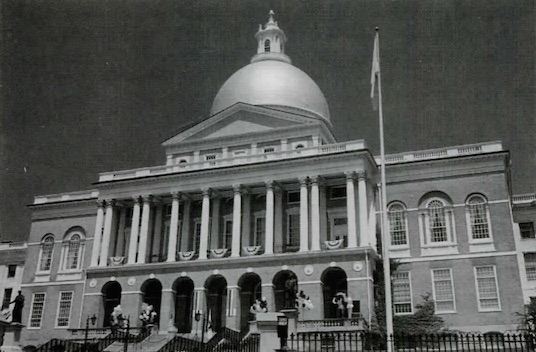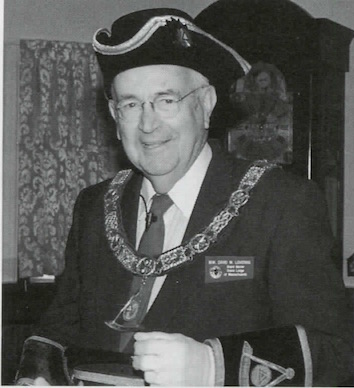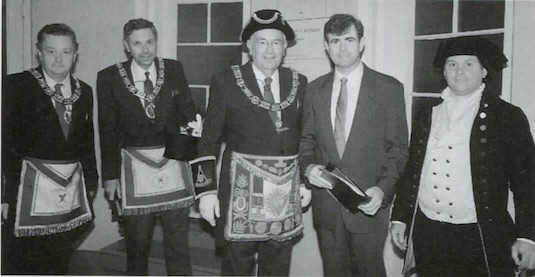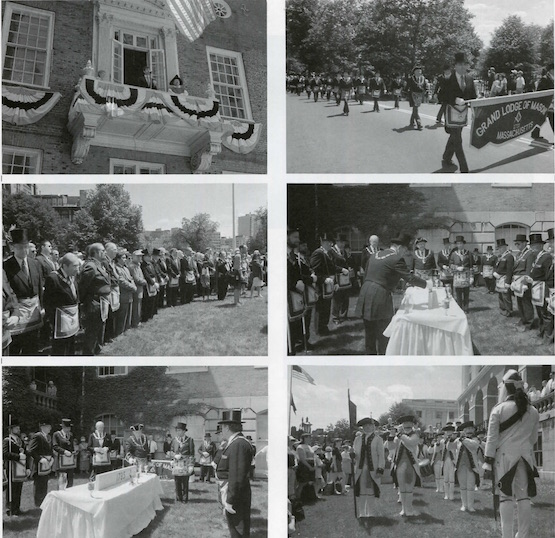MACornerstone1995
CORNERSTONE REENACTMENT, 1995

Grand Master Directs July Fourth Fete
By: R. W. Robert W. Williams, III
Photos by Bro. Alan R. Kravitz
Most Worshipful David W. Lovering, Grand Lodge officers and members of Lodges, over 300 strong, joined with Massachusetts government officials on July Fourth in a reenactment of the cornerstone laying of the Massachusetts State House. It was 200 years ago on Independence day when Grand Master Paul Revere, in his first year of office, accepted the invitation from Governor Samuel Adams to join in laying the cornerstone, only one month after the General Court had voted to erect a new building for a better and more convenient accommodation for the different departments of state government.
It is difficult to envisage the state of Beacon Hill in 1795 from any present-day associations, for at that time the summit still soared over Hancock's garden and pasture—a strange looking, cone-shaped mound sloping down to the site of the future State House. Two years later the design by Charles Bulfinch established the enduring character of Beacon Hill, and this building with its now famous Golden Dome has become the signature of Boston.
Think today of the thoughts that must have passed through the minds of Governor Adams. Grand Master Paul Revere and Junior Grand Warden Isaiah Thomas as they joined in the cornerstone laying only 20 years after the formation of American Independence. It was Brother Thomas who published the Massachusetts Spy, a paper that aroused the Patriots and agitated the British and Tories. When Revere rode his horse to alarm the countryside on April 18, 1775, Thomas took his press and type from his shop in the Old Oyster House and headed in oxen-pulled cart for a safer haven in Worcester. That press is now secured in the American Antiquarian Society, Worcester. (See Spring TROWEL 1985.) But no proof can be given that Samuel Adams ever received the degrees in Freemasonry. But credit him for recognizing the purpose of the Craft and Paul Revere.
As it had happened in 1795. the Fourth of July festivities of 1995 began at the old state house on State Street, once King Street and led to the present State House. In 1795 the assembly first met in Old South Church where once General and Brother Joseph Warren had made a famous speech. A truck, decorated with ribbons, held the cornerstone, drawn by 15 white horses, each with a leader, representing the 15 states that comprised the new nation in 1795. Governor Adams was a feeble man and in his speech he asked that the building which will rise over the cornerstone "remain permanent as the enduring mountains; may the principals of our excellent Constitution, found in nature and in the Rights of Man, be ably defended here." Grand Master Lovering and many other Masons have served this nation in defense of that government. Most Worshipful Paul Revere. Longfellow's most celebrated character in poetry must have agonized over the words he spoke that day. But he knew he was sharing in another chapter of history and he preserved his papers. "I congratulate you on this auspicious day; When the Arts and Sciences are establishing themselves among us in our happy country, a Country distinguished from the rest of the World by being a government of Laws, where Liberty has found a safe and secure abode, and where her sons are determined to support and protect her." He concluded with words of hope: "May we, my Brethren, so square our actions thro life as to show to the world of Mankind that we mean to live within the compass of Good Citizens, that we wish to stand upon the level with them, that when we part we may be admitted into the Temple where Reigns Silence and Peace."
Under the cornerstone was placed a silver plate inscribed with the doings of the day and giving the names of those who took part. The cannons boomed and the ceremony concluded. But. unlike our patriotic forebears, neither Governor William Weld nor Lt. Gov. Paul Cellucci attended the cornerstone laying ceremony. The invitation to Grand Lodge came from the Department of Tourism, doing its work on the home front.
On the seventh day of August. 1855. while workmen were making repairs to the State House foundation, upon removing the earth at the south-east corner of the building, they were surprised to find a few copper coins and a small leaden box which consisted of two pieces of sheet lead, loosely put together, without the usual solder generally used by workers in the metal business. The accident proved the rough granite stone, still in its place, was the cornerstone of the capitol and that the deposit made in July of 1795, was placed upon the soil with no other protection than a small quantity of cement employed by the operatives in the construction of the foundation of the building.
The three commissioners apprised Gov. Henry J. Gardner of their discovery and it was resolved that the same plate and coins be replaced, without any special display, under the new stone, in a securely prepared metal box hermetically sealed. Accordingly, on Saturday, August 11, 1855, just 60 years and thirty-eight days from the date of the original laying of the cornerstone, the ancient deposits were placed in a new metallic box, made for that purpose and replaced, without any special ceremony, by the regular successors of those who officiated in 1795, in the same corner, but under a newly hammered granite ashlar, resting upon another block of granite, firmly laid upon the new foundation.




Most Worshipful Winslow Lewis, M. D. was invited to participate with other officers and Brethren of the Grand Lodge of Massachusetts, in the presence of Governor Gardner, on the eleventh day of August A.D. 1855, A.L. 5855, did place silver coins of the United States currency of that year and copper cents and half cents of the last four years were likewise placed in a box, together with an impression of the state seal, the title-page of the first volume of the newly printed Massachusetts Colony Reports and morning papers of the day.
After the lid of the box was securely screwed down, the joints were well soldered and the box was cemented in an excavation prepared in the bottom face of the cornerstone which subsequently was set in its place in a firm manner, under the direction of the commissioners. Grand Master Winslow Lewis, for whom a Lodge is named and holding its meetings in the Grand Lodge building, addressed the small gathering, during which he thanked the governor and state officials for inviting Freemasonry to again take part. In part he said: "In placing this box it is the hope that the good Providence which has so long smiled upon us may still vouchsafe to us his continued blessings."
The participation of Grand Master David W. Lovering, Grand Lodge and Freemasonry is a reminder of the vigilance we must keep; that members of the Craft once left their plows and families to shoulder arms and to forge out a new nation of the people, for the people and by the people which we, as Masons, are obligated to protect. The Stalwart Builders of the past will not live again, we only reenact their deeds as reminders of what they built. The story pauses, as it did July Fourth 1995, but it does not end.
In his epilogue to the book Stalwart Builders, Most Worshipful Thomas S. Roy wrote, "New crises will be met and resolved by men just as concerned, just as dauntless, just as wise, and just as devoted as those who have brought Freemasonry to its present eminence. New opportunities will present themselves to make the Craft more relevant to the complex that will constitute the world of tomorrow. Our curiosity as to the past has, to some extent, been satisfied.
"The men of yesterday were equal to the demands made upon them. They laid the original cornerstone of the building and the nation. The only challenge they fling to us is implicit in their adequacy. They would have us emphasize the importance and necessity of the reality in Freemasonry; that we might sound it like a bell that our concern is not with a mysterious secrecy that guards words and symbols which have their own values to be sure, but do not constitute the reality of Freemasonry. Our concern is with great principles, the universals of life, by which alone men are to live if the world is to find its life."
No men had less material wealth than Samuel Adams and Paul Revere but they proved it is the internal and not the outward appearance that qualifies Masons to consider the welfare of others as we all face the struggles of life. It was Brother Revere's copper that covered the dome of the State House and sheet copper used for the ships like the U. S. S. Constitution. He looked at those challenges and said "he could do it as well as anybody." That's our challenge.
